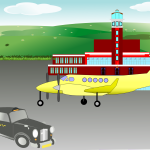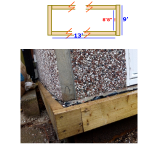Ambiguity

“This is Delta Bravo Twoah Oner Niner, ready for Taxi”
“He’s just on his way now. – Going to Paris Avenue or Road is it ‘guv?”[1]
“Call me a Taxi”[2]
“You’re a Taxi”
“The project output
should be limited
to 15 rows”
“I hope we don’t argue anywhere near that much!”
Whilst the examples above are intended to amuse they do highlight the need to be clear about your intention. Whilst they are a play on the English language, translations to and from customers and suppliers can cause equal ambiguity, especially if auto translated. Using a well known search engine the phrase “The ship shall have a 50m bow” translated to Greek “Το πλοίο θα έχει τόξο 50 μέτρων” and back again “The ship will have an arc of 50 meters” which could easily be interpreted as its turning ability rather than the size of the prow. We just hope they see sense and don’t order yards of ribbon. The addition of engineering drawings would, in this case have made the design request clear. It could also be achieved by having the requirements in a hierarchical order. If this sentence appeared as a sub requirement of dimensions rather then manoeuvrability.
Interpretation
What is smooth?

We have previously noted the difference between “should” and “shall”, that which is a desire and that which is a must. However, it is still important to remember the context and understanding of your stakeholders and suppliers. Say you need a framework to support a conveyor belt in a factory, you may contact a steelwork supplier. The required dimensions and weight bearing characteristics could be specified with a clear tolerance and safety margin. You may also specify that ‘all surfaces are smooth’ . The latter requirement being driven by the need to keep your employees and products from getting cuts or snagged from rough welds or sharp edges.
Your supplier is used to making conveyor systems for use in food and medical supply factories. To them ‘smooth’ implies a high quality stainless steel, with surface pitting limited to parts of a millimetre to allow for hygienic sterilisation. This sort of accuracy and finishing does not come cheap. A bit over the top given your conveyor is only moving some boxes of nails and screws to a palletising area. Whilst this would have given an over manufactured product that fulfilled the brief, it would have been far worse if the customer supplier situation had been reversed. It is important to remember there are many different view points depending where you sit in the chain. Understanding these differences and making your requirements match can reduce costs and prevent mistakes.
Manufacture

Even with clear unambiguous instructions, the implementation can still go awry. A requirement for a level concrete shed base that needed to be 13ft by 9ft, given to a local landscaper seemed pretty unambiguous. Dimensions and context were all clear. The site was cleared and the shuttering ordered. The 2″*4″(nominal) timber was cut and assembled. What could go wrong? Each piece of timber had been cut to a fairly precise tolerance. Oops! The width of the wood had not been taken into consideration. The internal width was therefore only 8’8″ and not 9ft…… Luckily this was caught by customer checking before the concrete was poured, otherwise it would have been very difficult to rectify. In many cases manufacture could be too far down the line to amend in the same way as the shuttering was extended. Prototypes and intermediate component validation can all help.
Take AIM
Plan and understand, to avoid requirement failure
- Avoid Ambiguity use sensible breakdown and context,
- Ensure all your suppliers and stakeholders make the same Interpretation
- Check the Manufacture meets the design
Use the right tools to make your job easier and traceable
Don’t try and juggle the data in many different silos. You should ensure your requirements, design, risks, and measurements are held in one linked dataset. Select Cradle and AIM for quality and success.
[1] The term “guv” or guv’ner a contraction of governor a colloquial deference to a ‘boss’ or ‘chief’
[2] The terms “cab” and “taxi” are accepted as synonymous. They refer to a vehicle that can be hired for transportation. Customers are picked up from one location and driven to another, the vehicle is known as a taxicab. The terms “cab” or “taxi” are derived from the same root. Cab is more common in the USA and Taxi more frequently used in the UK.

